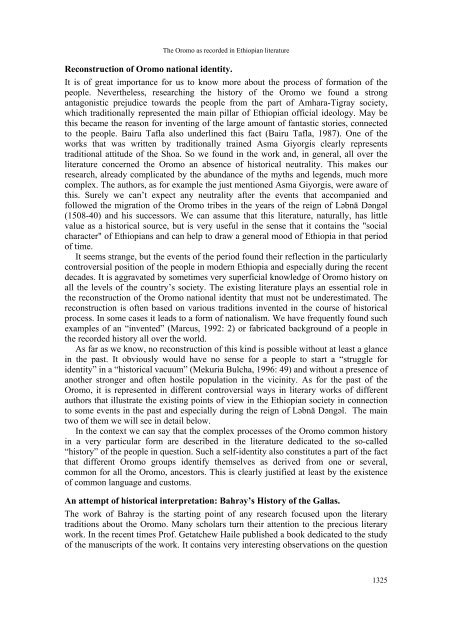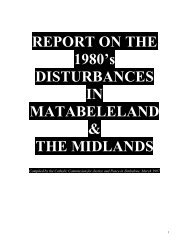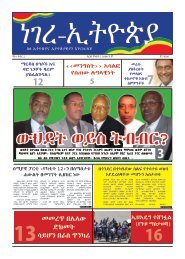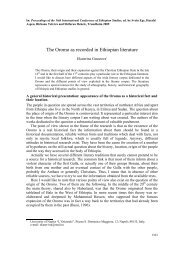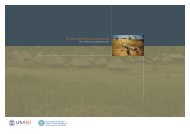Ekaterina Gusarova - The Oromo as recorded in Ethiopian literature
Ekaterina Gusarova - The Oromo as recorded in Ethiopian literature
Ekaterina Gusarova - The Oromo as recorded in Ethiopian literature
You also want an ePaper? Increase the reach of your titles
YUMPU automatically turns print PDFs into web optimized ePapers that Google loves.
<strong>The</strong> <strong>Oromo</strong> <strong>as</strong> <strong>recorded</strong> <strong>in</strong> <strong>Ethiopian</strong> <strong>literature</strong><br />
Reconstruction of <strong>Oromo</strong> national identity.<br />
It is of great importance for us to know more about the process of formation of the<br />
people. Nevertheless, research<strong>in</strong>g the history of the <strong>Oromo</strong> we found a strong<br />
antagonistic prejudice towards the people from the part of Amhara-Tigray society,<br />
which traditionally represented the ma<strong>in</strong> pillar of <strong>Ethiopian</strong> official ideology. May be<br />
this became the re<strong>as</strong>on for <strong>in</strong>vent<strong>in</strong>g of the large amount of fant<strong>as</strong>tic stories, connected<br />
to the people. Bairu Tafla also underl<strong>in</strong>ed this fact (Bairu Tafla, 1987). One of the<br />
works that w<strong>as</strong> written by traditionally tra<strong>in</strong>ed Asma Giyorgis clearly represents<br />
traditional attitude of the Shoa. So we found <strong>in</strong> the work and, <strong>in</strong> general, all over the<br />
<strong>literature</strong> concerned the <strong>Oromo</strong> an absence of historical neutrality. This makes our<br />
research, already complicated by the abundance of the myths and legends, much more<br />
complex. <strong>The</strong> authors, <strong>as</strong> for example the just mentioned Asma Giyorgis, were aware of<br />
this. Surely we can’t expect any neutrality after the events that accompanied and<br />
followed the migration of the <strong>Oromo</strong> tribes <strong>in</strong> the years of the reign of Ləbnä Dəngəl<br />
(1508-40) and his successors. We can <strong>as</strong>sume that this <strong>literature</strong>, naturally, h<strong>as</strong> little<br />
value <strong>as</strong> a historical source, but is very useful <strong>in</strong> the sense that it conta<strong>in</strong>s the "social<br />
character" of <strong>Ethiopian</strong>s and can help to draw a general mood of Ethiopia <strong>in</strong> that period<br />
of time.<br />
It seems strange, but the events of the period found their reflection <strong>in</strong> the particularly<br />
controversial position of the people <strong>in</strong> modern Ethiopia and especially dur<strong>in</strong>g the recent<br />
decades. It is aggravated by sometimes very superficial knowledge of <strong>Oromo</strong> history on<br />
all the levels of the country’s society. <strong>The</strong> exist<strong>in</strong>g <strong>literature</strong> plays an essential role <strong>in</strong><br />
the reconstruction of the <strong>Oromo</strong> national identity that must not be underestimated. <strong>The</strong><br />
reconstruction is often b<strong>as</strong>ed on various traditions <strong>in</strong>vented <strong>in</strong> the course of historical<br />
process. In some c<strong>as</strong>es it leads to a form of nationalism. We have frequently found such<br />
examples of an “<strong>in</strong>vented” (Marcus, 1992: 2) or fabricated background of a people <strong>in</strong><br />
the <strong>recorded</strong> history all over the world.<br />
As far <strong>as</strong> we know, no reconstruction of this k<strong>in</strong>d is possible without at le<strong>as</strong>t a glance<br />
<strong>in</strong> the p<strong>as</strong>t. It obviously would have no sense for a people to start a “struggle for<br />
identity” <strong>in</strong> a “historical vacuum” (Mekuria Bulcha, 1996: 49) and without a presence of<br />
another stronger and often hostile population <strong>in</strong> the vic<strong>in</strong>ity. As for the p<strong>as</strong>t of the<br />
<strong>Oromo</strong>, it is represented <strong>in</strong> different controversial ways <strong>in</strong> literary works of different<br />
authors that illustrate the exist<strong>in</strong>g po<strong>in</strong>ts of view <strong>in</strong> the <strong>Ethiopian</strong> society <strong>in</strong> connection<br />
to some events <strong>in</strong> the p<strong>as</strong>t and especially dur<strong>in</strong>g the reign of Ləbnä Dəngəl. <strong>The</strong> ma<strong>in</strong><br />
two of them we will see <strong>in</strong> detail below.<br />
In the context we can say that the complex processes of the <strong>Oromo</strong> common history<br />
<strong>in</strong> a very particular form are described <strong>in</strong> the <strong>literature</strong> dedicated to the so-called<br />
“history” of the people <strong>in</strong> question. Such a self-identity also constitutes a part of the fact<br />
that different <strong>Oromo</strong> groups identify themselves <strong>as</strong> derived from one or several,<br />
common for all the <strong>Oromo</strong>, ancestors. This is clearly justified at le<strong>as</strong>t by the existence<br />
of common language and customs.<br />
An attempt of historical <strong>in</strong>terpretation: Bahrəy’s History of the Gall<strong>as</strong>.<br />
<strong>The</strong> work of Bahrəy is the start<strong>in</strong>g po<strong>in</strong>t of any research focused upon the literary<br />
traditions about the <strong>Oromo</strong>. Many scholars turn their attention to the precious literary<br />
work. In the recent times Prof. Getatchew Haile published a book dedicated to the study<br />
of the manuscripts of the work. It conta<strong>in</strong>s very <strong>in</strong>terest<strong>in</strong>g observations on the question<br />
1325


